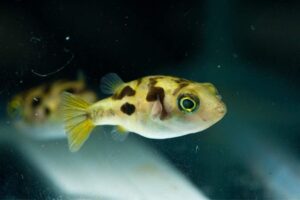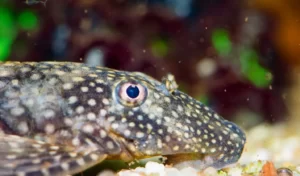
Neon Tetra Breeding: Comprehensive Guide For Beginners

Writer at The Aquarium Keeper
Breeding the neon tetra is a fascinating journey that captivates fishkeeping enthusiasts around the world, but at the same time, it is one of the hardest things you could do in this hobby.
If you’re an aspiring aquarist looking to take your fishkeeping hobby to the next level, understanding the art of breeding neon tetras is a rewarding endeavor. In this comprehensive guide, we’ll explore the ins and outs of neon tetra breeding, from their behavior and habitat to practical tips on successful breeding.
Neon Tetras: A Brief Overview
Neon tetras, with the scientific name Paracheirodon innesi, are renowned for their dazzling blue and red stripes, making them a top choice for aquarium keepers. Their mesmerizing coloration creates a captivating shimmer as they glide through the water, making them a visual delight in any aquarium.
Their petite size, typically around 1.5 inches (3.8 cm), further enhances their visual appeal, making them a popular choice for aquarists looking to add a splash of color to their tanks without the need for a large space.

These fishes are known for their gentle disposition, making them excellent community fish. They coexist harmoniously with a wide range of tankmates, allowing aquarists to create vibrant and diverse aquatic communities. Their peaceful demeanor not only reduces the risk of aggression in the tank but also makes them an ideal choice for beginners in the world of fishkeeping.
Neon tetras have the tendency to exhibit schooling behavior. In the wild, they travel in large groups for safety, and this instinct carries over into the aquarium. Observing a school of neon tetras gracefully navigating the water together is a sight to behold. The sense of unity and movement they bring to the tank adds an element of natural beauty and serenity to any aquatic environment.

The adaptability of neon tetras is another standout feature that endears them to aquarists. These fish can thrive in a variety of tank conditions, from soft to moderately hard water and slightly acidic to neutral pH levels.
| Aspect | Information |
|---|---|
| Scientific Name | Paracheirodon innesi |
| Common Name | Neon Tetra |
| Origin | South America - Amazon Basin |
| Rarity | Common |
| Price | $1 - $2 USD |
| Care Level | Easy |
| Water Temperature | 24°C - 27°C (75°F - 80°F) |
| pH | 6.0 - 6.5 |
| Minimum Tank Size | 10 gallons |
| Diet | Omnivore - Flakes, Pellets, Live/Frozen Foods, Algae |
| Temperament | Peaceful |
| Lifespan | 3 - 5 years |
| Size | 1 - 1.5 inches |
Their wide tolerance for water parameters makes them versatile and well-suited to a range of aquarium setups, whether it’s a planted tank, a community tank, or a species-specific setup. This adaptability simplifies the process of creating a suitable environment for neon tetras, allowing aquarists to focus on other aspects of fishkeeping, such as maintaining water quality and providing a balanced diet.
You might also like to read: Ultimate Albino Neon Tetra Care Guide
Neon Tetra Breeding Behavior
In their natural habitat of South America, breeding the neon tetra is known to occur during the rainy season when water conditions change. Understanding their breeding behavior is key to replicating these conditions in a controlled setting like an aquarium.
This species is renowned for its captivating synchronized spawning, a fascinating phenomenon that occurs in their natural habitat in the Amazon basin and has been observed in captivity as well. Synchronized spawning, also known as group spawning, is a remarkable reproductive strategy that sets neon tetras apart from many other fish species.
This behavior showcases their social complexity and evolutionary adaptations for survival, per a study in the journal Biosystems Engineering. This process typically begins with the males, who initiate courtship displays to attract the attention of females. During these courtship displays, males flaunt their vibrant colors and engage in elegant fin displays to court potential mates. The synchronized nature of these displays is an essential precursor to group spawning.
As females become receptive to mating, they join the males in a mesmerizing dance of synchronized swimming. This coordinated swimming often occurs near densely planted areas, which serve as safe havens for egg deposition. As the females release their eggs, the males simultaneously release their sperm, resulting in fertilization in real time. This precise
coordination ensures that the fertilized eggs are distributed evenly among the aquatic vegetation, enhancing their chances of survival.
Breeding Neon Tetras Sucessfully
Successfully breeding neon tetras involves several steps. Begin by setting up a separate breeding tank, ideally a 10 to 20-gallon aquarium, equipped with a sponge filter to ensure gentle water circulation. Then it is important to add both male and female neon tetras into the tank.
Sexing Neon Tetras
To determine the sex of neon tetras, you can look for subtle differences in their physical characteristics. However, it’s important to note that these differences can be quite challenging to discern, especially in younger or less mature fish.

There are some key differences between male and female neon tetras. Here is a list of things to look at when sexing neon tetras:
- Body shape and size: Mature female neon tetras tend to have slightly plumper bodies, especially when they are
carrying eggs. This can be a subtle difference and may not always be apparent, particularly in younger fish. Females may grow slightly larger than males, but this size difference can be quite minimal and may not always be a reliable indicator. - Coloration: In some cases, females may display slightly deeper or more rounded bellies compared to males, especially when they are ready to breed. Some aquarists believe that females might have a slightly paler blue stripe compared to males, which may appear more intense and vibrant.
- Fins: Male neon tetras may have slightly more extended and pointed dorsal fins, whereas females’ dorsal fins are often shorter and more rounded. However, this difference can be subtle and may not always apply to all.
Timing And Age of Neon Tetra Breeding
Neon tetras typically reach breeding maturity at around 9 to 12 months of age. Once they’ve reached this stage, they will be more receptive to breeding triggers and suitable for the breeding process. Keep in mind that proper conditioning and
patience is essential to achieve successful breeding.
Encouraging Neon Tetras to Breed
Creating the right environment for neon tetras to breed is essential. To encourage neon tetras to breed successfully, replicate their natural habitat as closely as possible in your aquarium. Maintain stable water parameters with a slightly acidic pH of around 6.0 to 6.5 and a temperature between 75°F to 80°F (24°C to 27°C). Additionally, a well-balanced diet rich in
high-quality flakes, live or frozen foods will prepare them for breeding.
As for breeding triggers, neon tetras often prefer to spawn in densely planted tanks. Consider adding java moss, fine-leaved plants, or spawning mops to create safe havens for the eggs. If you are new to aquarium plants and don’t have much experience, column feeder aquarium plants would be more suited for you, since they don’t need to be planted, and will definitely help replicate neon tetra natural habitat. During the breeding process, males will engage in courtship behavior, culminating in the females laying eggs, which will adhere to the plants.
Hatching And Early Development
Once breeding neon tetras is successful, the fertilized eggs will undergo development, eventually hatching into fry. These eggs are adhesive and will adhere to various surfaces, such as leaves, plants, or even the glass of an aquarium.
The incubation period for neon tetra eggs typically lasts between 24 and 36 hours, with the duration influenced by water temperature. Higher temperatures shorten the incubation time but may increase the risk of deformities in the fry, per a study in the International Journal of Life Sciences. One notable threat to developing eggs is fungal infections, which can be prevented by using a fungicide or adding a few drops of methylene blue.

As the neon tetra eggs near hatching, they exhibit movement and wiggling. Upon hatching, the baby neon tetras emerge from the eggs with their yolk sacs still attached. During the initial days after hatching, these fry rely on their yolk sacs for nutrition and do not require external feeding. Once the yolk sacs are fully absorbed, the neon fry becomes free-swimming and can begin feeding on small, suitable foods.
Caring for neon tetra fry can be a delicate process. As with the adults, ensure a well-balanced diet for the young fry, including infusoria, baby brine shrimp, and powdered fry food. Frequent water changes and pristine water quality are crucial for their development.
After Hatching And Rearing
After the successful hatching of neon tetra fry, it’s important to provide them with appropriate care and conditions for their growth and development. Typically, neon tetra fry are kept in a separate rearing tank to protect them from potential predation by adult fish. The recommended time frame for keeping neon tetra fry in their own tank can vary but is typically around 3 to 4 weeks. During this period, it’s essential to maintain stable water parameters and provide them with appropriate nutrition, such as infusoria or specially formulated fry food.
Introducing neon tetra fry to adult tetras should be done with caution. It’s advisable to wait until the fry is large enough to avoid being seen as prey by the adult tetras. A size of approximately 0.5 inches (1.3 cm) is often considered suitable for this transition. Slowly acclimating them to the main tank over a period of time can help reduce stress and increase their chances of survival.
Neon Tetra Breeding Challenges
Breeding the neon tetra may come with its share of challenges. Common issues include egg predation, poor water quality, and unsuccessful breeding attempts. To address these challenges, consider isolating the eggs or adjusting water parameters as needed. Regular monitoring and quick intervention can often resolve issues and improve breeding success.
Personal Experience And Final Thoughts
In conclusion, breeding neon tetras can be a rewarding and educational experience for aquarists of all levels. Understanding their behavior, creating a conducive environment, and following the breeding process diligently are key to a successful neon tetra breeding venture.
Personally, I have tried breeding neon tetras before, but I found it difficult to replicate their natural habitat. It is truly challenging to get these species to breed, but once it happens, it is truly an amazing thing to experience. I believe, that the first breeding attempts are the hardest, and with the ever more growing experience, anyone can successfully breed neon tetras.
Frequently Asked Questions
How Many Eggs do Neon Tetras Lay?
Female neon tetras usually lay from 40 to 120 eggs, that get fertilized by the male. The amount of eggs can differ because every neon tetra female is different, it depends on their health, and in what kind of environment they live in.
Will Neon Tetras Breed in Community Tank?
The chances that neon tetras will actually breed in a community tank are slim to none. These species need precise conditions in order to breed. Nevertheless, if neon tetras would breed in a community tank, there is a danger that other fish might eat the eggs.



Pea Puffer: Adorable Little Hunter, Everything You Need To Know



